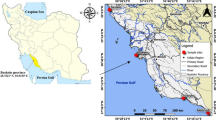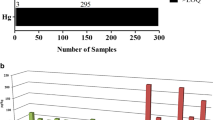Abstract
The levels of metallic trace elements were determined in fishery products sampled from Tunisian fishing ports. Mean concentrations were 0.20 ± 0.01, 0.05 ± 0.01, and 0.10 ± 0.01 mg/kg in fish flesh for Hg, Cd, and Pb, respectively. The mean concentrations of these elements were below regulatory thresholds; however, we also detected some specimens with higher levels. The mercury level showed a significant difference between fish categories, region, and year of sampling (p < 0.05). Samples from the center sites had the highest levels of Pb (0.17 ± 0.03 mg/kg; range 0.10; 0.22 mg/kg). Temporal analysis of Pb showed a significant difference between sampling year (p < 0.05). In addition, distribution among fish categories was statistically significant (p = 0.046). The rates of samples exceeding limits of Hg, Cd, and Pb were 5.3, 2.6, and 0.4%, respectively. Through the above results, the maximum weekly and monthly intakes for fish flesh consumption could not exceed the set limits. These data were important to inform consumers about fish content and the risk generated by some of these species.



Similar content being viewed by others
Availability of Data and Material
Not applicable.
References
Miquel G (2000) Rapport sur les effets des métaux lourds sur l’environnement et la santé. Off Parlem d’évaluation des choix Sci Technol Rapp d’information n° 261
Okyere H, Voegborlo RB, Agorku SE (2015) Human exposure to mercury, lead and cadmium through consumption of canned mackerel, tuna, pilchard and sardine. Food Chem 179:331–335. https://doi.org/10.1016/J.FOODCHEM.2015.01.038
Programme des Nations Unies Pour l’Environnement (2011) Etat du mercure dans les pays Méditerranéens 1–268
Galimberti C, Corti I, Cressoni M, Moretti VM, Menotta S, Galli U, Cambiaghi D (2016) Evaluation of mercury, cadmium and lead levels in fish and fishery products imported by air in North Italy from extra-European Union countries. Food Control 60:329–337. https://doi.org/10.1016/J.FOODCONT.2015.08.009
Hammerschmidt CR, Lamborg CH, Fitzgerald WF (2007) Aqueous phase methylation as a potential source of methylmercury in wet deposition. Atmos Environ 41:1663–1668. https://doi.org/10.1016/J.ATMOSENV.2006.10.032
Mozaffarian D, Rimm EB (2006) Fish intake, contaminants, and human health. JAMA 296:1885–1899. https://doi.org/10.1001/jama.296.15.1885
Yabanli M, Alparslan Y (2015) Potential health hazard assessment in terms of some heavy metals determined in demersal fishes caught in Eastern Aegean Sea. Bull Environ Contam Toxicol 95:494–498. https://doi.org/10.1007/s00128-015-1584-7
Zhu H, Chen C, Xu C, Zhu Q, Huang D (2016) Effects of soil acidification and liming on the phytoavailability of cadmium in paddy soils of central subtropical China. Environ Pollut 219:99–106. https://doi.org/10.1016/J.ENVPOL.2016.10.043
Règlement (CE) N° 1881/2006 de la Commission du 19 décembre (2006) portant fixation de teneurs maximales pour certains contaminants dans les denrées alimentaires. J Off l’Union Eur 5–24
Word Health Organization (2010) WHO Human Health Risk Assessment Toolkit: Chemical Hazards
WHO/JECFA (a) (2011) WHO | JECFA. In: Eval. Jt. FAO/WHO Expert Comm. Food Addit. Mercur. https://apps.who.int/food-additives-contaminants-jecfa-database/chemical.aspx?chemID=1806. Accessed 17 Apr 2020
WHO/JECFA (2013) WHO | JECFA. In: Eval. Jt. FAO/WHO Expert Comm. Food Addit. Cadmium. https://apps.who.int/food-additives-contaminants-jecfa-database/chemical.aspx?chemID=1376. Accessed 17 Apr 2020
WHO/JECFA (b) (2011) WHO | JECFA. In: Eval. Jt. FAO/WHO Expert Comm. Food Addit. Lead. https://apps.who.int/food-additives-contaminants-jecfa-database/chemical.aspx?chemID=3511. Accessed 17 Apr 2020
Observatoire National de l’Agriculture (2018) Observatoire National de l’Agriculture. http://www.onagri.nat.tn/indicateurs?id=7. Accessed 19 Sep 2019
Règlement (CE) N° 333/2007 DE LA COMMISSION du 28 mars (2007) portant fixation des modes de prélèvement d’échantillons et des méthodes d’analyse pour le contrôle officiel des teneurs en plomb, en cadmium, en mercure, en étain inorganique, en 3- MCPD et en b. J Off l’Union Eur 29–38
AFSSA (2006) Avis de l’Agence française de sécurité sanitaire des aliments relatif à la consommation des poissons prédateurs pélagiques, en particulier l’espadon, à la Réunion vis-à-vis du risque sanitaire lié au méthylmercure. Saisine n° 2006-SA-0003 1–6
European Food Safety Authority (2012) Scientific opinion on the risk for public health related to the presence of mercury and methylmercury in food. EFSA J:10. https://doi.org/10.2903/j.efsa.2012.2985
Munthe J, Bodaly RAD, Branfireun BA et al (2007) Recovery of mercury-contaminated fisheries. Ambio 36:33–44
Ben Salem Z, Ayadi H (2016) Assessment of heavy metal contamination levels and toxicity in sediments and fishes from the Mediterranean Sea (southern coast of Sfax, Tunisia). Environ Sci Pollut Res 23:13954–13963. https://doi.org/10.1007/s11356-016-6534-3
Kojadinovic J, Potier M, Le Corre M et al (2006) Mercury content in commercial pelagic fish and its risk assessment in the Western Indian Ocean. Sci Total Environ 366:688–700. https://doi.org/10.1016/J.SCITOTENV.2006.02.006
Chekri R, Reninger J-C, Thierry G, Noël L (2017) Surveillance des éléments traces métalliques dans les denrées alimentaires d’origine animale - focus sur le plan exploratoire de la recherche du méthylmercure dans les poissons. Bull Epidemiol Hebd 77:18–22
Kimáková T, Kuzmová L, Nevolná Z, Bencko V (2018) Fish and fish products as risk factors of mercury exposure. Ann Agric Environ Med 25:488–493. https://doi.org/10.26444/aaem/84934
Millour S, Noël L, Kadar A, Chekri R, Vastel C, Sirot V, Leblanc JC, Guérin T (2011) Pb, Hg, Cd, As, Sb and Al levels in foodstuffs from the 2nd French total diet study. Food Chem 126:1787–1799. https://doi.org/10.1016/j.foodchem.2010.12.086
Nurul Izzah A, Mohd Fairulnizal Mohd N, Wan Rozita Wan M et al (2015) The mercury levels in crustaceans and cephalopods from Peninsular Malaysia. Environ Sci Pollut Res 22:12960–12974. https://doi.org/10.1007/s11356-015-4415-9
Elahi M, Esmaili-Sari A, Bahramifar N (2012) Total mercury levels in selected tissues of some marine crustaceans from Persian Gulf, Iran: variations related to length, weight and sex. Bull Environ Contam Toxicol 88:60–64. https://doi.org/10.1007/s00128-011-0451-4
Bustamante P, Lahaye V, Durnez C, Churlaud C, Caurant F (2006) Total and organic Hg concentrations in cephalopods from the North Eastern Atlantic waters: influence of geographical origin and feeding ecology. Sci Total Environ 368:585–596. https://doi.org/10.1016/j.scitotenv.2006.01.038
Rjeibi M, Metian M, Hajji T, Guyot T, Ben Chaouacha-Chékir R, Bustamante P (2014) Interspecific and geographical variations of trace metal concentrations in cephalopods from Tunisian waters. Environ Monit Assess 186:3767–3783. https://doi.org/10.1007/s10661-014-3656-2
Penicaud V, Lacoue-Labarthe T, Bustamante P (2017) Metal bioaccumulation and detoxification processes in cephalopods: a review. Environ Res 155:123–133. https://doi.org/10.1016/j.envres.2017.02.003
Bonsignore M, Salvagio Manta D, Mirto S, Quinci EM, Ape F, Montalto V, Gristina M, Traina A, Sprovieri M (2018) Bioaccumulation of heavy metals in fish, crustaceans, molluscs and echinoderms from the Tuscany coast. Ecotoxicol Environ Saf 162:554–562. https://doi.org/10.1016/J.ECOENV.2018.07.044
MétéoPolitique (2018) Déversements et fuites d’hydrocarbures (pétrole, mazout, diésel, etc) en 2018. http://meteopolitique.com/fiches/petrole/deversements-de-petrole/2018/Deversements-de-petrole-en-2018.htm. Accessed 19 Sep 2019
Ben Khemis I, Besbes Aridh N, Hamza N et al (2017) Heavy metals and minerals contents in pikeperch (Sander lucioperca), carp (Cyprinus carpio) and flathead grey mullet (Mugil cephalus) from Sidi Salem Reservoir (Tunisia): health risk assessment related to fish consumption. Environ Sci Pollut Res 24:19494–19507. https://doi.org/10.1007/s11356-017-9586-0
Engel DW, Brouwer M (1986) Cadmium and copper metallothioneins in the American lobster, Homarus americanus. Environ Health Perspect 65:87–92. https://doi.org/10.1289/ehp.866587
Rainbow PS, White SL (1989) Comparative strategies of heavy metal accumulation by crustaceans: zinc, copper and cadmium in a decapod, an amphipod and a barnacle. Hydrobiologia 174:245–262. https://doi.org/10.1007/BF00008164
Rodrigo AP, Costa PM (2017) The role of the cephalopod digestive gland in the storage and detoxification of marine pollutants. Front Physiol 8:232. https://doi.org/10.3389/fphys.2017.00232
Zuluaga Rodríguez J, Gallego Ríos SE, Ramírez Botero CM (2015) Content of Hg, Cd, Pb and as in fish species: a review. Rev Vitae 22:148–149. https://doi.org/10.17533/udea.vitae.v22n2a09
Chouba L, Mzoughi-Aguir N (2006) Les métaux traces (Cd , Pb , Hg) et les hydrocarbures totaux dans les sédiments superficiels de la frange côtière du Golfe De Gabes. Bull Inst Natn Scien Tech Mer Salammbô 33:93–100
Melki S, Gueddari M (2018) Impact assessment of phosphogypsum leachate on groundwater of Sfax-Agareb (southeast of Tunisia): using geochemical and isotopic investigation. J Chem 2018:1–10. https://doi.org/10.1155/2018/2721752
Guérin T, Chekri R, Vastel C, Sirot V, Volatier JL, Leblanc JC, Noël L (2011) Determination of 20 trace elements in fish and other seafood from the French market. Food Chem 127:934–942. https://doi.org/10.1016/J.FOODCHEM.2011.01.061
Chahid A, Hilali M, Benlhachimi A, Bouzid T (2014) Contents of cadmium, mercury and lead in fish from the Atlantic Sea (Morocco) determined by atomic absorption spectrometry. Food Chem 147:357–360. https://doi.org/10.1016/j.foodchem.2013.10.008
ANSES (2016) Impact potentiel sur la santé humaine du rejet en Méditerranée d’effluents issus des activités de transformation de minerai de bauxite. Appui Sci Tech l’Anses Saisine n° 2014-SA 0223:1–74. 2011-SA-0133
Chouba L, Kraiem M, Njimi W et al (2007) Seasonal variation of heavy metals (Cd, Pb and Hg) in sediments and in mullet, Mugil cephalus (Mugilidae), from the Ghar El Melh Lagoon (Tunisia). Transitional Waters Bull 1:45–52. https://doi.org/10.1285/i1825229Xv1n4p45
Chaouay A, Okhrib R, Hilali M et al (2016) Contribution à l’étude de l’analyse physico-chimique et de la contamination métallique de l’eau de mer du littoral d ‘Agadir (Sud du Maroc). J Mater Environ Sci 7:2748–2759
Acknowledgments
The authors thank Mrs. Salma Masmoudi (Central Laboratory of Analysis and Tests, Tunisia) for her technical support.
Funding
This work was supported by the General Directorate of Veterinary Services, Ministry of Agriculture, Fisheries and Hydraulic Ressources, 1002 Tunis, Tunisia.
Author information
Authors and Affiliations
Contributions
Samia Zrelli, Safa Amairia: conceptualization, methodology, formal analysis, writing—original draft; Mohamed Chaabouni: methodology; Walid Oueslati: investigation; Olfa Chine, Amira Nachi Mkaouar, Ali Cheikhsbouii: resources; Roua Ghorbel: data curation; Malek Zrelli: supervision
Corresponding author
Ethics declarations
The manuscript does not contain clinical studies or patient data. There are no ethical concerns to be reported and fishery products were not alive at sampling time. In addition, international methods standards have been met, during fishing.
Conflict of Interest
The authors declare that they have no conflicts of interest.
Code Availability
Not applicable.
Additional information
Publisher’s Note
Springer Nature remains neutral with regard to jurisdictional claims in published maps and institutional affiliations.
Rights and permissions
About this article
Cite this article
Zrelli, S., Amairia, S., Chaabouni, M. et al. Contamination of Fishery Products with Mercury, Cadmium, and Lead in Tunisia: Level’s Estimation and Human Health Risk Assessment. Biol Trace Elem Res 199, 721–731 (2021). https://doi.org/10.1007/s12011-020-02179-8
Received:
Accepted:
Published:
Issue Date:
DOI: https://doi.org/10.1007/s12011-020-02179-8




